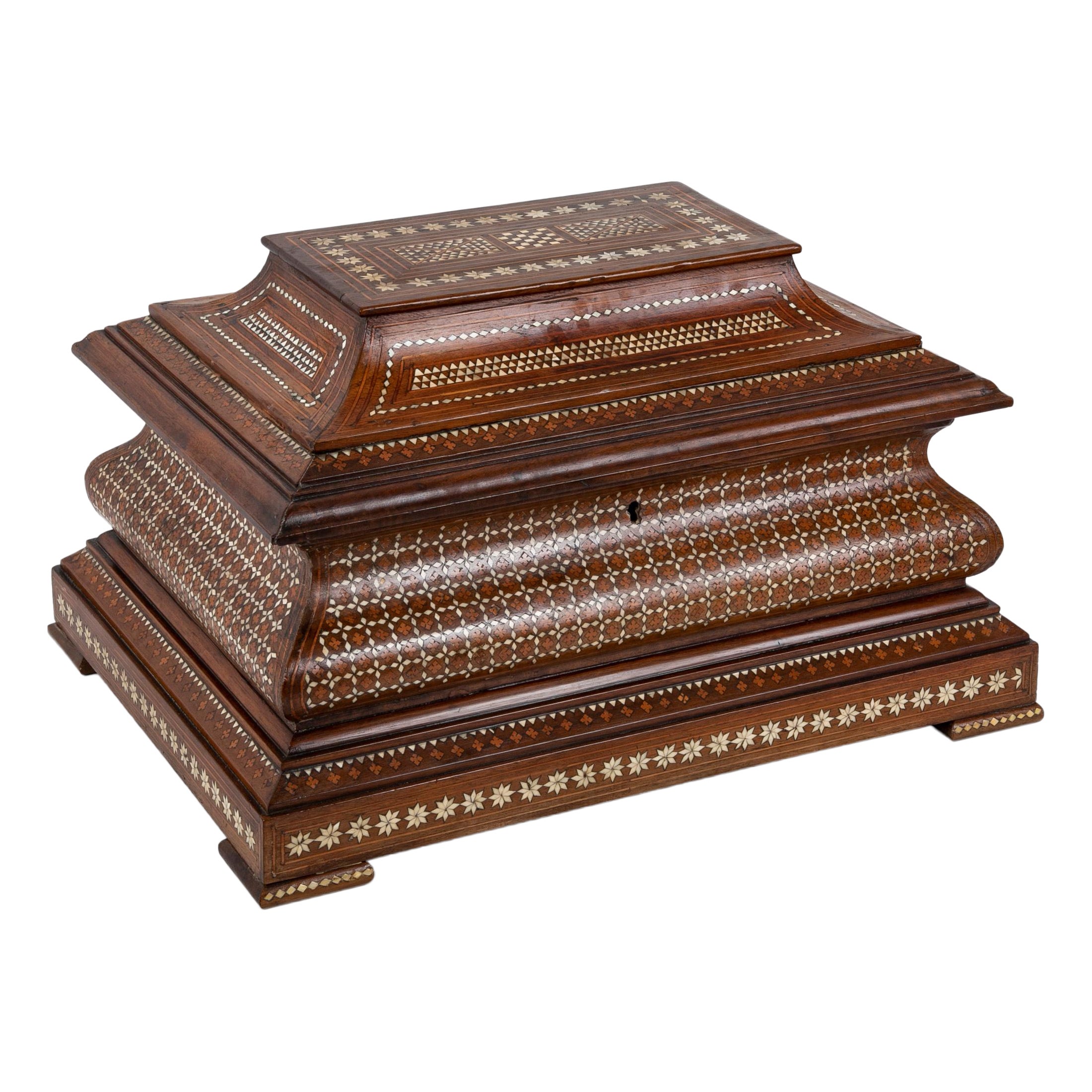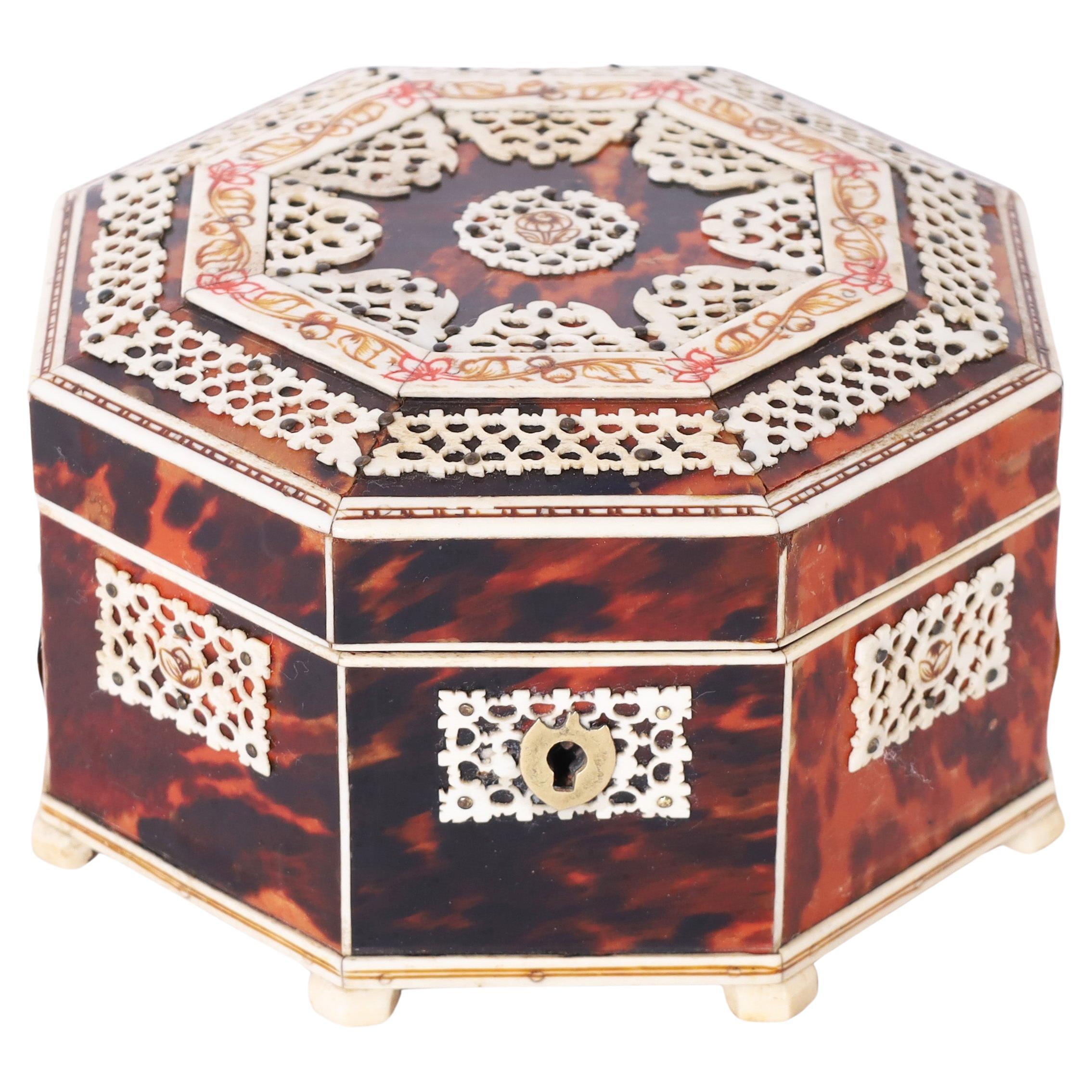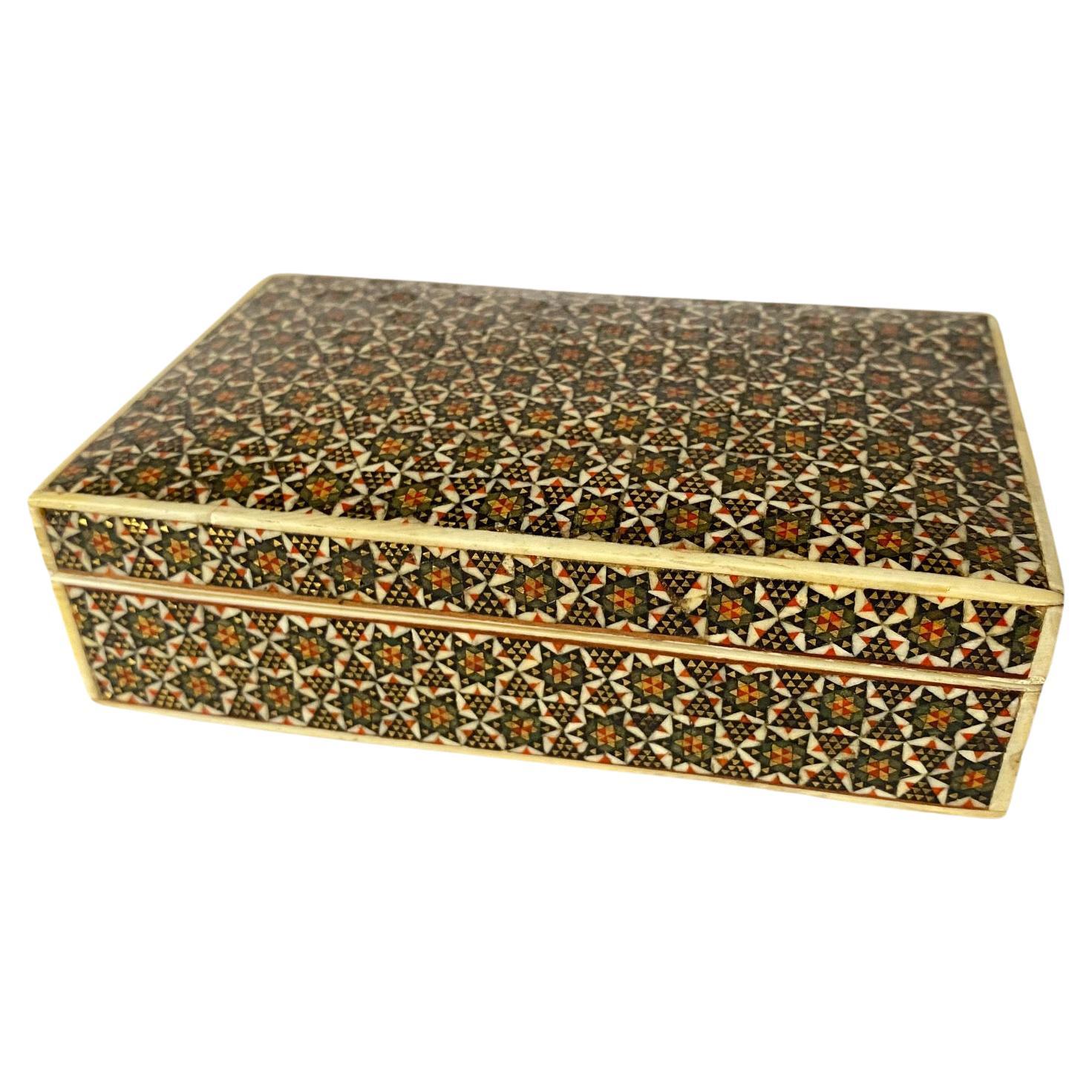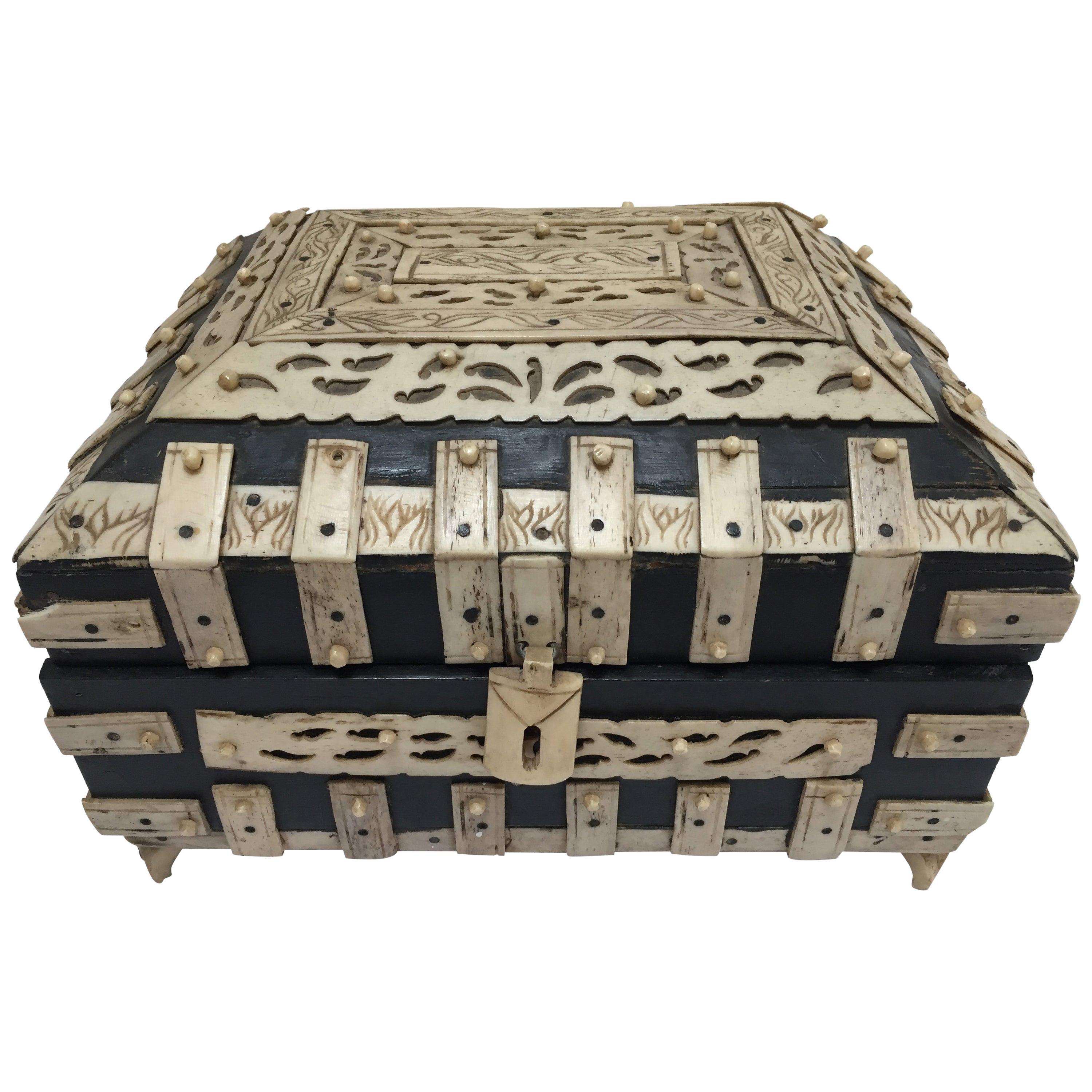Items Similar to Anglo Indian Brass Box with Bone Inlay
Want more images or videos?
Request additional images or videos from the seller
1 of 14
Anglo Indian Brass Box with Bone Inlay
About the Item
A handsome and unusual brass strongbox with intricate patterned polished bone inlay on the top. The inside with a till, the lid of the till decorated with incised designs. This box could be polished but I prefer the patina of age. Some verdigris spots here and there only add to the allure. No key. Ceylon, (Sri Lanka) circa 1900.
Measures: 8 inches wide by 3 high by 5.25 deep.
- Dimensions:Height: 3 in (7.62 cm)Width: 8 in (20.32 cm)Depth: 5.25 in (13.34 cm)
- Style:Anglo-Indian (Of the Period)
- Materials and Techniques:
- Place of Origin:
- Period:
- Date of Manufacture:1900
- Condition:
- Seller Location:Stamford, CT
- Reference Number:1stDibs: LU803014958431
About the Seller
5.0
Platinum Seller
These expertly vetted sellers are 1stDibs' most experienced sellers and are rated highest by our customers.
Established in 1990
1stDibs seller since 2004
407 sales on 1stDibs
Typical response time: <1 hour
- ShippingRetrieving quote...Ships From: Stamford, CT
- Return PolicyA return for this item may be initiated within 14 days of delivery.
More From This SellerView All
- Anglo Indian Decorative Box with Painted Figures of DancersLocated in Stamford, CTVery decorative hand painted in the Anglo-Indian style. Painted back and gold with each framed panel filled with female dancers and male flower bearing suiters. A colorful and fun, a...Category
Mid-20th Century Indian Anglo-Indian Decorative Boxes
MaterialsWood
- 19th Century Anglo-Indian Sadeli Inlaid Work Box Traveling Writing DeskLocated in Stamford, CTA stunning camel bone, ebony and metal inlaid sadeli work box with portable writing desk, Bombay, circa 1850. The sandalwood body of faceted rec...Category
Antique Mid-19th Century Indian Anglo-Indian Decorative Boxes
MaterialsMetal
- 19th Century English Regency Mahogany Box With Satinwood InlayLocated in Stamford, CTEnglish Regency mahogany box with satinwood inlay. The four corners of the top are inlaid with lovely triangular scalloped decoration. All the border molding are also satinwood inlay...Category
Antique Early 19th Century English Regency Decorative Boxes
MaterialsMahogany, Satinwood
- American Walnut and Fruit Wood Box With Geometric Inlay, Circa 1900Located in Stamford, CTWonderful 19th century American box with intricate and beautiful geometric inlay. This was created by a true craftsman. Interior painted with removable sectioned tray. 15.75 inches ...Category
Early 20th Century American Folk Art Decorative Boxes
MaterialsFruitwood, Walnut
- 19th Century American Rosewood Box With Fruit Wood Star Inlay, Fun InteriorLocated in Stamford, CTA beautifully made hand carved rosewood and fruit wood box with heart shaped bone escutcheon.The whimsical interior lined with paper carpet pattern from...Category
Antique Late 19th Century American Decorative Boxes
MaterialsGlass, Fruitwood, Rosewood
- Whaler Made Bone and Ebonized Wood Round Lidded Box, circa 1850Located in Stamford, CTWhaler made antique bone and ebonized wood round box, circa 1850. With pierced bone medallion and delicately carved bone spiral decorative supports on the...Category
Antique Mid-19th Century American Folk Art Decorative Boxes
MaterialsBone, Wood
You May Also Like
- Anglo-Indian Hardwood Casket with Bone InlayLocated in Stamford, CT19th century Anglo-Indian hardwood casket with bone inlay. India.Category
Antique Mid-19th Century Indian Decorative Boxes
MaterialsHardwood
- Anglo Indian Tortoise and Bone BoxLocated in Palm Beach, FLImpressive Anglo Indian box crafted in mahogany and clad in tortoise shell decorated with bone straps, carved and painted floral panels, and paw feet. The inside has a mirror and bon...Category
Early 20th Century Indian Anglo-Indian Decorative Boxes
MaterialsBone, Tortoise Shell
- Vizagapatam Anglo-Indian Rectangular Box with Bone InlaidLocated in North Hollywood, CAFabulous Anglo-Indian decorative box inlaid. Made in Vizagapatam, situated on the south east coast of India, near Madras. Great decorative inlaid pen box or jewelry box. Inside dimen...Category
20th Century Indian Anglo-Indian Decorative Boxes
MaterialsSandalwood
- Antique Anglo Indian Bone and Tortoise BoxLocated in Palm Beach, FLImpressive antique Anglo Indian box crafted in mahogany, clad in tortoise shell, and ambitiously decorated with bone. The inside has a mirror and red felt lining.Category
Antique 19th Century Indian Anglo-Indian Decorative Boxes
MaterialsBone, Tortoise Shell
- Anglo Indian Micro Mosaic Inlay Jewelry BoxLocated in New York, NYExquisitely crafted early 20th century Anglo Indian micro mosaic Sadeli box with gorgeous antique Persian geometric pattern. The finely detailed box featu...Category
Early 20th Century Indian Anglo-Indian Jewelry Boxes
MaterialsFruitwood, Bone
- Anglo-Indian Vizagapatam Bombay Mughal Style Footed Box With Bone OverlayLocated in North Hollywood, CANice and unusual Indian Mughal style large decorative box, filigree and carved horn. Anglo-Indian footed domed box with exceptional engraved details throughout with filigree and carved veneered bone plaques with arabesque carving. Vizagapatam, late 19th century. History of the Anglo-Indian Boxes Beginning in the early part of the 18th century, Indian artisans made what came to be known as Anglo-Indian boxes for the English residents living in India, who eventually brought or sent them back to England. At the beginning of the 19th century, India began exporting these boxes commercially, although not in any significant numbers until the 1850s. People valued them so highly that manufacturers of tins copied the designs on them in the late 19th and early 20th century. Anglo-Indian boxes fall into four groups: Rosewood or ebony boxes inlaid; sandalwood boxes veneered; sandalwood boxes covered with Sadeli mosaic; and carved boxes often combined with Sadeli mosaic/ The first two categories came from Vizagapatam in East India while the last two came from Bombay in West India. English traders discovered the rich woods and intricate workmanship of Indian artisans, so colonial government officials began to recognize the work of the Indian artists and craftsmen as a source for satisfying the need for furniture and boxes, which would both serve to enhance English households in India. This gave rise to the cabinetmaking workshops in Vizagapatam between Calcutta and Madras. Craftsmen made the first boxes to be decorated with Sadeli mosaic of rosewood or ebony, incised to give further definition to the decoration, directly inlaid into the wood. The shape of the early boxes was either sloping at the front with a flatter section at the back, reminiscent of English writing slopes, or rectangular. Artisans inlaid the borders with stylized floral scrolls and the centers with a single floral motif following a circular or oval symmetrical or asymmetrical pattern. The edging was ornamental and protective, both helped protect the end grain against the weather. Made in Vizagapatam, situated on the south east coast of India, near Madras These exotic boxes...Category
Antique Late 19th Century Indian Anglo Raj Decorative Boxes
MaterialsWood
Recently Viewed
View AllMore Ways To Browse
Furniture With Inlay
Brass Inlay Furniture
Deep Box
Indian Objects
Anglo Indian Furniture Antique
Antique Anglo Indian Furniture
Anglo Indian Antique Furniture
Brass Lidded Box
Inlayed Bone
Bone Inlayed Furniture
Bone Inlay
Bone Inlay Furniture
Brass Box With Lid
Indian Brass
Indian Brass Furniture
Brass Inlay Box
Decorate Boxes With Lids
Ceylon Sri Lankan





